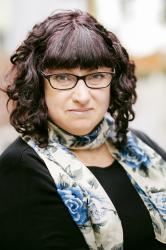La Sonnambula
La sonnambula is a simple story made special by Bellini’s ravishing music. Such music of course requires a ravishing soprano – as Amina, the sleepwalker of the title, Opera Australia star Emma Matthews sings with exquisite beauty and confirms her place as Australia’s reigning queen of bel canto.
Opera AustraliaArts Centre Melbourne Opening Night, Friday 30 April, 2010
For this premiere season of La sonnambula emerging Australian director Julie Edwardson has transposed the action from the Italy of the 19th century to a Swiss village in the early 1900s. Seeking to explore the psychoanalytic theories of Freud and Jung in regard to dreams and the subconscious, the production draws inspiration from the visual art of the period, namely German expressionism, to create a space that teeters between reality and fantasy.
The design, by Richard Roberts, is a simple box dominated by a raised, raked, rectangular revolve. A rustic theme is established through the initial impression of being in a barn somewhere in Switzerland, with the superb lighting design of Matt Scott transforming the wide planes of the flats throughout the opera. The perhaps over-utilised revolve fulfils the purpose of creating a variety of perspectives in what could otherwise be static scenes, but comes into its own in the final dream sequence. As the grief stricken Amina walks in a trance, the changing angles of the revolve carry her on an otherworldly journey – seemingly floating through space. This is surely one of the most haunting images I have ever seen on the opera stage.
Edwardson’s direction reflects her previous career as an opera singer in its respect of the importance, especially in bel canto, of the music. In contrast to much of opera these days, there is a minimum of distracting background business during the principal’s set pieces; and the singers are unhampered by too much direction when they are delivering the often devilishly difficult arias. This approach works best when you have a cast of splendid artists who are up to meeting the musical and dramatic demands of the piece.
As Amina’s betrothed Elvino, Mexican tenor Jorge Lopez-Yanez sings with bright gusto and brings a confused vulnerability to his character when required. As the sophisticated outsider, Count Rodolfo, Joshua Bloom could use a bit of loosening up on the physical side, but can be forgiven just about anything with his seductively warm voice that fills the theatre, apparently with very little effort.
Soprano Taryn Fiebig, hot from a demanding stint in Bliss, copes well with completely different vocal challenges in the role of Amina’s rival Lisa. She also brings a considerable stage presence, and surprising comic timing, to the unsympathetic character.
The OA chorus get to shine in this opera – Bellini has them accompany many of the pivotal moments in the opera – and they are, in effect, an extra character in the drama. Their singing was impeccable, and they displayed an obvious enjoyment in their role.
The night though, belongs to Matthews. In a remarkable musical collaboration with revered conductor Richard Bonynge, she creates a unique interpretation of the starring role. Matthews cleverly makes a virtue of the relative lightness of her voice, drawing the audience in, forcing us to listen. Her sweet piano upper notes speak to the frailty of her character, and as her voice warms though the evening so does her sound, culminating in a finale of infectious joy.
All of this was made possible by the extraordinarily sensitive conducting of the Orchestra Victoria by Bonynge, who seemed to hang onto Matthew’s every breath – the night almost felt like a intimate duet between those two artists.
This style of bel canto opera can present a challenge to audiences (and production teams) accustomed to the more straightforward drama of the verismo operas of composers like Verdi or Puccini. Admittedly, La sonnambula starts slowly, saving the best music for later, and the long, repetitive arias can feel like they are holding up the drama for the sake of a bit of showing off from the principals. Sometimes it even feels like you are at a “sing off”, with applause for each big sing punctuating the music.
But this La sonnambula, with its commitment to the substance of the story coupled with superlative singing and music making, transcends such banality. It is a deserved triumph for all involved.
Playing Dates: May 6, 8, 12, 15, and 17, 2010
Bookings: www.ticketmaster.com.au or 1300 136 166

